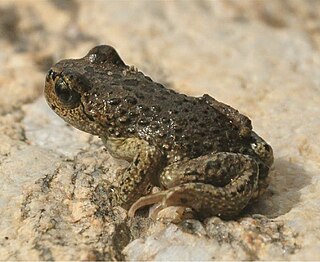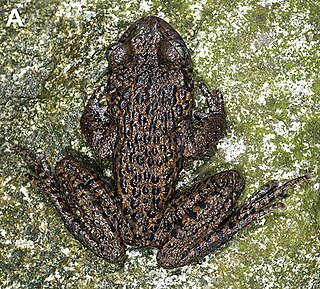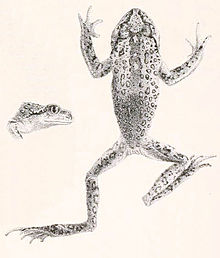
Eastern spadefoot toads comprise a genus of the family Megophryidae in the order Anura, and are found in southern China, northeast India, southeast Asia, and islands of the Sunda Shelf as well as the Philippines. They are characterized by a stocky body with slender, short hindlimbs. In identifying species, iris colour is a valuable diagnostic morphological characteristic ; the iris has uniform colour in some species, whereas in other species the upper half is coloured and the lower half is dark.

Megophrys is a genus of frogs in the family Megophryidae. They occur in the mainland Southeastern Asia, the islands of the Sunda Shelf, and the Philippines. They commonly have elongated upper "eyebrows" and are thus known as Asian horned frogs.

Scutiger boulengeri is a species of toad in the family Bufonidae. It is found in Nepal, India (Sikkim) and western China. A healthy population has been found at an elevation of 5,270 m (17,290 ft) in one of the lakes in the Gurudongmar Lake complex in Sikkimese Himalaya. This is one of the highest elevations where amphibians have ever been recorded.

Scutiger sikimmensis is a species of toad in the family Bufonidae. It is found in northeastern India, Nepal, Bhutan, and Tibet. Many common names have been coined for this species: Sikkim lazy toad, Sikimmese pelobatid toad, Sikkim high altitude toad, Sikkim spade foot frog, Blyth's short-limbed frog, and Sikkim snow toad. It is very common in the high altitudes of Sikkimese Himalaya.
Oreolalax chuanbeiensis is a species of amphibian in the family Megophryidae. It is endemic to northern Sichuan, China where it is found in Pingwu County and Mao County. Its natural habitats are temperate forests and rivers. It is threatened by habitat loss.

Oreolalax is a genus of amphibian in the family Megophryidae. They are mostly endemic to southwestern China, with one species in northern Vietnam, and possibly extending into adjacent Laos. There is also a population in Arunachal Pradesh that has not yet been assigned to a species, although it might rather be a Scutiger.
Scutiger adungensis is a species of frog in the family Megophryidae. It is only known with certainty from two specimens collected in 1931 from Adung Valley in northern Myanmar, near the border to Tibet; there are more recent unconfirmed sightings. Common name Adung lazy toad has been coined for it.
Scutiger chintingensis, also known as the Chinting lazy toad or Chinting alpine toad, is an endangered species of amphibian in the family Megophryidae. It is endemic to the Mount Emei region of Sichuan, China.
Scutiger jiulongensis, also known as Juilong cat-eyed toad, is a species of frog in the family Megophryidae. It is endemic to Jiulong County in southern Sichuan Province, China. Its natural habitats are subtropical or tropical moist montane forests, rivers, swamps, and freshwater marshes.
Scutiger maculatus, the spotted lazy toad or Piebald alpine toad, is a species of frog in the family Megophryidae. It is endemic to China where it is known from Garze, northwestern Sichuan and Jiangda, eastern Tibet. Its natural habitats are temperate forests, temperate shrubland, subtropical or tropical high-altitude grassland, and rivers. It is threatened by habitat loss.
Scutiger mammatus is a species of frog in the family Megophryidae. It is endemic to Western China and known from eastern Tibet, southeastern Qinghai, western Sichuan, and northwestern Yunnan.
Scutiger muliensis is a species of amphibian in the family Megophryidae. It is endemic to Sichuan, China, where it is only known from the area of its type locality in Muli county, altitude 3,050–3,400 m (10,010–11,150 ft) asl. Its common name is Muli cat-eyed toad.
Scutiger ningshanensis is a species of toad in the family Megophryidae known commonly as the Ningshan lazy toad and Ningshan alpine toad. It is endemic to Ningshan County in Shaanxi, China. It is a poorly known species; only two specimens have been collected, both from one location. The species has been recorded in grassy habitat near forest streams at up to 2550 meters in elevation. It may face threats from small-scale farming in the area.
Scutiger pingwuensis is a species of toad in the family Megophryidae known commonly as the Pingwu lazy toad and the Pingwu alpine toad. It is endemic to Pingwu County in Sichuan, China. It lives near villages at about 2200 meters in elevation. Its habitat includes streams bordered by dense shrubs. It lays eggs under rocks in the streams.

Scutiger spinosus is a species of toad in the family Megophryidae. It is found in Medog County, Tibet (China) and in Tawang district, Arunachal Pradesh (India). Prior to its description in 2016, it was confused with Scutiger nyingchiensis. Common name spiny lazy toad has been coined for it.

Scutiger wuguanfui is a species of toad in the family Megophryidae. It is endemic to Tibet and only known from its type locality in the Medog County. The specific name wuguanfui honours Wu Guanfu, a Chinese herpetologist. Common names Wu's lazy toad, Medog lazy toad and Medog cat-eyed toad have been coined for it.







